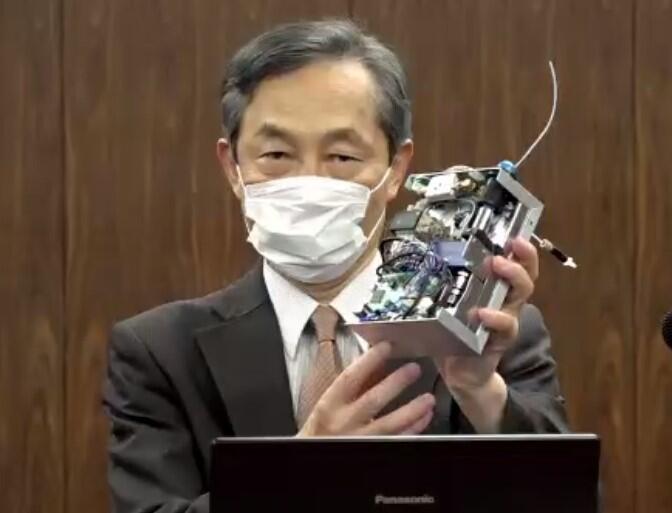If airborne novel coronavirus particles can be detected rapidly, it will be possible to conduct concerts and meetings in which food and drink are consumed without a mask by simply testing the virus at the entrance of the venue. Ball Wave Inc., Tohoku University Graduate School of Medicine, and Toyoda Gosei have developed a sensor that detects proteins from the novel coronavirus from aerosols within 1 minute by applying ball surface wave acoustic (SAW) sensor technology. The group plans to solve issues, such as the devices sensitivity and characteristics, within the year and demonstrate its practical application in 2023 with an eye on putting it on the market from 2024. However Shingo Akao, (CEO of Ball Wave Inc.), is enthusiastic about accelerating this schedule and making the sensor available to society as soon as possible.
Professor Emeritus Yamanaka (Director of R&D of Ball Wave Inc. and Professor Emeritus of Tohoku University) and his colleagues have developed a ball SAW sensor that uses SAWs, which propagate along the surface equator of the ball, and repeatedly orbit it without spreading laterally. Ball Wave was established with the support of JST's Program for Creating STart-ups from Advanced Research and Technology (START) for its practical application. The SAW sensor can be applied in gas chromatography because it can accurately measure the weight of the material attached to the ball surface. Professor Emeritus Yamanaka said, "At our discussion at the New Industry Creation Hatchery Center of Tohoku University around April last year, we were asked if the SAW sensor could be applied to breath, so we started with the development of this device."
In the development, the researchers constructed a sensitive membrane with antibodies and aptamers on the surface of a sphere to detect the novel coronavirus. As droplets and aerosols in the air contain water; the water causes an antigen-antibody reaction to recognize and capture the novel coronavirus.
To start, whether an aerosol causes a high-speed antigen-antibody reaction was examined. When the antigen was fixed to the bottom of ELISA plate wells and an aerosol containing the antibody was sprayed for 1-20 seconds, it was confirmed that the antigen could be specifically captured in 1 second. It was confirmed that the detection sensitivity of this assay was the same as that of normal ELISA. When an aerosol containing an antigen was sprayed on the sensor surface of the prototype ball SAW virus sensor principle verifier, the mass load response of the sensor peaked within 5 seconds and returned to a constant value within 1 minute. Repeated spraying resulted in an integrated increase in the response. This resulted in the successful capture of proteins from the novel coronavirus in aerosols within 1 minute.
The aptamer, a nucleic acid molecule that specifically binds to a specific foreign substance and inhibits its function, is more thermally and chemically stable than an antibody and is reusable by opposing the binding with the foreign substance with an increase in temperature, and so, the virus and the antigen can be separated by applying a certain temperature after detection. It was confirmed, in principle, that the novel coronavirus can be detected from aerosols; however, there are a few concerns that need to be addressed before applying the assay in practical settings.
Professor Emeritus Yamanaka said, "From now on, to verify the specificity of recognizing only the novel coronavirus, we will confirm that it does not react with influenza virus and the common cold virus. In addition, it is also necessary to cooperate with the Graduate School of Medicine to confirm the sensitivity of detecting the exhaled breath of infected individuals and viruses in spaces with many infected individuals. The stability of the device also needs to be confirmed. We would like to solve these issues in a year." In the future, the researchers hope that the surface treatment technology that Toyoda Gosei has generated in the development of interior and exterior car parts and the highly accurate diagnostic methods/ "breathomics" technology that can detect viruses and inflammatory proteins in exhaled breath, developed by the Tohoku University Graduate School of Medicine, can be used alongside the technology of Ball Wave to proceed with joint research projects.

Credit: Ball Wave Inc.
This article has been translated by JST with permission from The Science News Ltd.(https://sci-news.co.jp/). Unauthorized reproduction of the article and photographs is prohibited.




